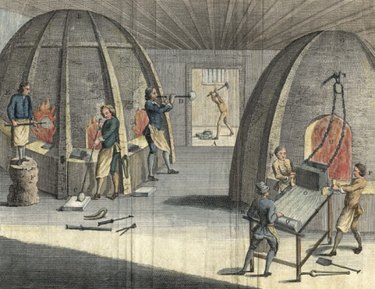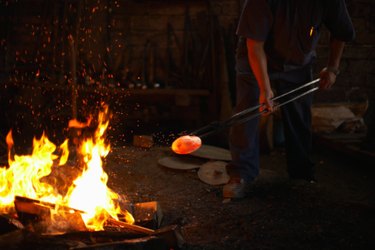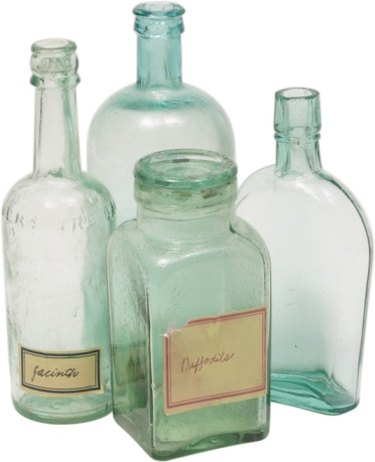
In the early days of glassblowing, leaving the glassmaking island of Murano with the knowledge of how to blow glass was a crime punishable by death. In 1612, the secrets were revealed in a book by Antonio Neri and the craft spread rapidly throughout Europe and eventually to the new colonies in America. The tools that accompanied the migration were the glassblower's prized possessions, often handed down from generation to generation. Glassblowers brought these tools with them when they came to colonial America.
Traditional Tools
Video of the Day

Glassblowing tools have changed very little over the centuries. Tools that were used by early Roman glassblowers were also used by the glass masters of Murano. The early glassblowers in Jamestown, in 1607, used the same tools that are used by glassblowers today. These tools were hand forged by blacksmiths. An expert blacksmith could make more refined tools and make it easier to work with the hot molten glass.
Video of the Day
Basic Tools
The most used tools on the Colonial glassmaker's bench were the pontil, or punty, and the blowpipe. The glassmaker blew through the blowpipe to create a bubble within a mass of molten glass. He manipulated the bubble to form bottles, glasses and bowls as well as fishing floats and window glass. The glassblower used a punty to gather a ball of glass. He attached the glass ball to the bubble to form handles, goblet feet and decorative touches. He also used the punty to safely detach the finished glassware from the blowpipe.
Shaping Tools

Bench tools used by colonial glass blowers included jacks. Shaped like giant tweezers, jacks were used to draw the glass out and shape vase openings and bottle necks. Carved wooden molds, called blocks, were soaked in water before use. Their long handles allowed the glassblower to force the glass into the mold, where the steaming wood could smooth the bubble into the perfect sphere. Shears could cut the soft glass away from goblet rims and the mouths of vases. Flat paddles produced straight flat sides and bottoms on bottles and jugs.
Glass Molds
Cast iron molds imprinted a pattern on a glass bottle or bowl. Some of these molds were simple cones that the glass could be forced over or into to create ribs or patterns. More elaborate molds were made in two parts. The small glass bubble was inserted into the mold before being blown. The mold was then removed to reveal a shaped and decorated piece.